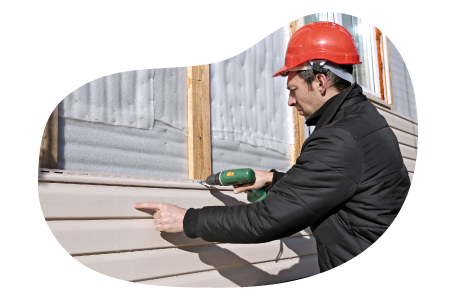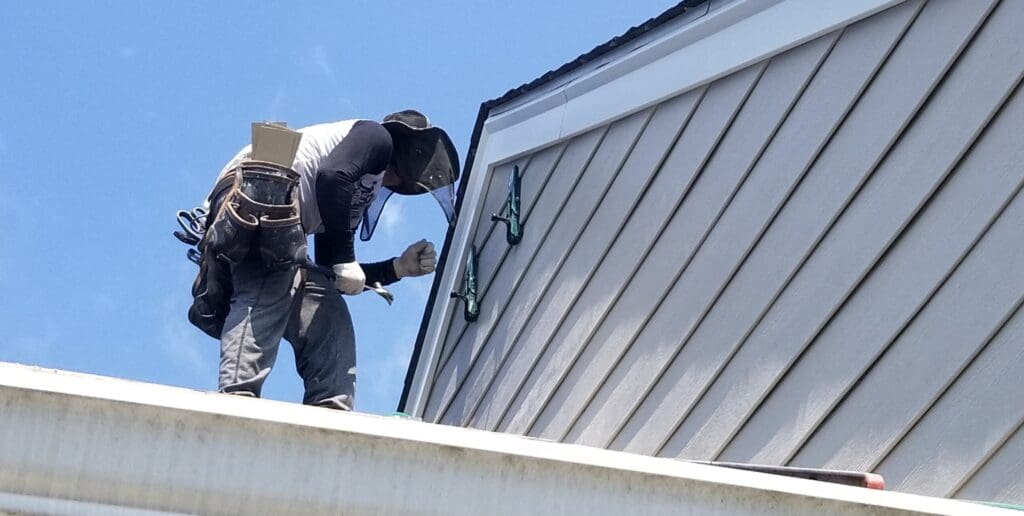The Crucial Guide to the Various Sorts Of Home Siding and Their Special Advantages
In the world of home enhancement, selecting the best house siding is an important decision that impacts both visual appeal and practical efficiency. With so numerous options to take into consideration, which exterior siding material absolutely stands out for your specific job?
Wood Siding
Timber home siding, a prominent selection for domestic outsides, provides an ageless visual that incorporates natural appeal with structural integrity. This house siding product is available in various designs, consisting of clapboard, roof shingles, and board-and-batten, enabling homeowners to tailor their appearance to match their layout preferences. Timber house siding is commonly crafted from long lasting varieties such as cedar, redwood, or ache, which are understood for their strength and ability to withstand environmental stressors.
Among the primary benefits of timber siding is its outstanding insulation buildings, which can add to power effectiveness and lower heating costs. In addition, wood house siding is biodegradable, making it an ecologically friendly choice when sourced sustainably. Regular maintenance, consisting of painting or discoloration, can extend its lifespan and improve its look, permitting homeowners to protect the natural beauty of the timber.
Nevertheless, prospective drawbacks consist of sensitivity to insects, rot, and weather condition damage, requiring ample treatment and maintenance - morris siding contractor. Despite these worries, when properly taken care of, wood house siding can offer a attractive and long lasting remedy that enhances the personality of a home while supplying a cozy, inviting ambience

Vinyl Home Siding
Plastic exterior siding has become a leading choice for property owners looking for a low-maintenance exterior alternative that incorporates sturdiness and price. This versatile material is crafted from polyvinyl chloride (PVC), making it resistant to numerous weather conditions, including moisture and UV rays. Therefore, vinyl exterior siding does not warp, rot, or discolor, making certain resilient aesthetic charm.
Among the key benefits of vinyl home siding is its considerable array of designs and colors, enabling homeowners to achieve the desired search for their building without the demand for constant repainting. In addition, vinyl siding is very easy to install, which can significantly lower labor costs throughout construction or renovation projects.
Plastic exterior siding additionally contributes to power effectiveness. Lots of alternatives attribute insulation backing, which improves thermal performance, aiding to maintain comfortable interior temperatures and possibly decreasing energy costs. Its smooth surface facilitates very easy cleansing, requiring only regular cleaning with a garden hose to eliminate dirt and debris.
Fiber Cement Home Siding
Fiber concrete exterior siding has gained grip among home builders and property owners alike as a result of its impressive combination of longevity and visual convenience. Composed of a combination of cellulose, cement, and sand fibers, this home siding choice is engineered to withstand extreme weather problems, including high winds, heavy rain, and temperature variations, making it a lasting option for property outsides.

Among the key advantages of fiber concrete exterior siding is its resistance to parasites, such as termites, and its non-combustible nature, offering improved fire safety and security. morris siding contractor. Additionally, it is readily available in a broad array of styles, structures, and shades, permitting house read what he said owners to accomplish their wanted aesthetic without compromising performance
Another advantage is its low upkeep demands; fiber cement siding usually requires painting or staining every 5-10 years, which is much less regular than various other materials. In addition, its long life contributes to a reduced overall cost of possession, as it minimizes the requirement for frequent repair work or substitutes.
Inevitably, fiber concrete siding stands for a superb financial investment for those seeking a durable, appealing, and functional outside alternative, integrating both kind and feature to improve the home's visual charm.
Metal Home Siding
The allure of steel exterior siding hinges on its durable resilience and modern visual allure, making it a popular choice for contemporary style. Available in materials such as light weight aluminum and steel, steel house siding offers a variety of surfaces and colors, allowing property owners to attain a customized look that complements their layout vision.

Energy effectiveness is an additional substantial advantage, as several metal house siding items are developed with insulation options that assist control indoor temperatures. This can bring about decreased energy expenses gradually. Furthermore, steel siding is usually recyclable, making it an ecologically friendly option for sustainability-minded house owners.
The setup procedure for metal siding can be reasonably simple, resulting in a quicker turn-around time for building and construction jobs. In general, steel house siding integrates performance and style, making it a useful alternative for those seeking a aesthetically attractive and long-lasting outside finish.
Block and Rock Home Siding
Brick and rock house siding stands out as a classic selection that enhances the visual charm of any home. Recognized for their toughness and low upkeep, these materials provide an extraordinary roi while raising the home's visual allure. Offered in numerous shades, structures, and patterns, block and rock can be tailored to suit diverse architectural styles, from traditional to contemporary.
One of the key benefits of block and rock house siding is their energy performance. Both products have natural protecting buildings that aid control indoor temperature levels, potentially decreasing heating & cooling expenses. Furthermore, they supply exceptional fire resistance contrasted to various other exterior siding check this site out choices, contributing to improved safety and security.
One more advantage is their durability. Brick and stone can last for years, commonly calling for marginal maintenance beyond occasional cleansing. Unlike wood house siding, they are impervious to bugs and rot, making certain a durable outside that withstands the components.
Conclusion
In recap, the selection of exterior siding dramatically impacts site here a home's aesthetic appeal, power performance, and upkeep needs. Each type of exterior siding-- whether wood, vinyl, fiber brick, metal, or concrete and stone-- provides unique advantages tailored to different home owner preferences and ecological problems.
One of the key benefits of timber house siding is its superb insulation properties, which can contribute to energy effectiveness and reduced home heating prices. Additionally, wood exterior siding is biodegradable, making it an ecologically pleasant option when sourced sustainably.One of the key benefits of metal house siding is its resistance to different environmental factors.Power efficiency is one more significant benefit, as several steel home siding products are designed with insulation options that assist regulate indoor temperatures. Each kind of siding-- whether wood, plastic, fiber brick, steel, or cement and rock-- supplies one-of-a-kind advantages customized to various house owner choices and environmental problems.